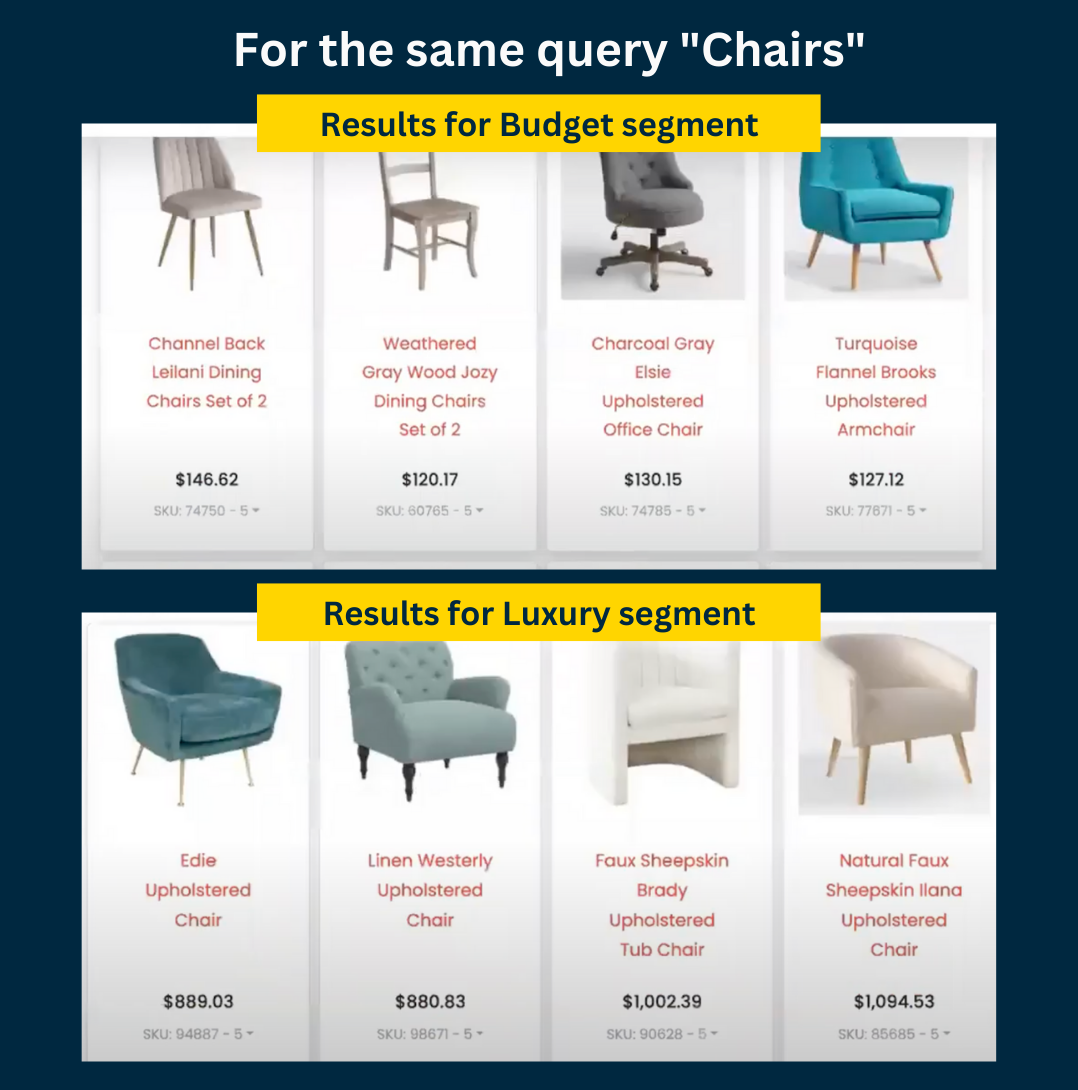Segmented search
This guide provides an overview of the Discovery Segmented search feature.
Segmented search was previously called Real-Time Segments (RTS)
What is Segmented search
Segmented search personalizes the product search, category, and pathway results in real time based on customer demographic and behavioral data. The feature combines Discovery’s extensive search algorithms and Bloomreach Engagement’s rich customer data to get the best of both worlds.

Why is this feature valuable for your business
Hyper-personalization of search engines allows search results to be tailored to customer needs and wants. Every customer is unique and has their own preferences. Therefore, when searching for the same keyword, different customers expect different results. For instance, an avid hiker and a cyclist are looking for distinct products, even when searching for the same keyword, “shoes.”
The final result is an enjoyable, relevant, and effortless online experience leading to higher conversion rates and driving RPV.
Large-scale personalization may be challenging and time-consuming and can require multiple teams to deploy. However, Segmented search overcomes this issue and allows you to personalize search results easily.
Concepts
Segmentations: Segmentations allow you to divide customers into smaller groups based on common characteristics or activities. These can include demographics, interests, purchasing behaviors, or any other factors that can help you understand how these groups differ from each other. Visit this article to learn more about Segmentations.
How does Segmented search work
-
Exposing Segmentation and Data Training: Firstly, identify the proper segmentations - groups of customers based on their shared attributes in Engagement to target them more effectively. By exposing this segmentation data, Discovery then proceeds to a 30-day data training where algorithms build personalized rankings for each segment.
-
AB Test and Optimize Results: Once the data training period is complete, you can proceed to AB test the segmentation. AB testing lets you optimize the degree of personalization by evaluating the performance of segmented search results versus default search results.
-
Go LIVE: Finally, you can go live to all site traffic so that segment-optimized search results are served to all site traffic in real time.
Use case examples
You can use this feature to enhance search results by returning and ranking products in the context of the segment within which the site visitor belongs. For instance, you’ll be able to rank products more effectively for the following segments:
- Male vs Female
- Mountain Biker vs Road Biker
- Plumber vs Electrician
You can achieve all these use cases using the customer_tier dimension. An example is illustrated below:

The segmentation in this example buckets buyers into Budget and Luxury segments based on their price affinity. For the same query, “Chairs”, customers will see different results based on the segment they fall into. Budget segment shoppers will see low-cost products, while Luxury segment shoppers will see more premium products in the search results.
Feature enablement
This feature must be enabled on your account by Bloomreach. If you would like to enable this feature, please consult your Customer Success Manager (CSM) or Business Services Consultant.
If you’re integrating the Real Time Segmented Ranking feature, you can inspect the segments data using Events Management.
Limitations
General limitations
- For the initial implementation, the Discovery pixel and analytics pipeline require 30 days to collect segmentation data. After this, personalization happens fast.
- The customer should cache the results by segment for no longer than 24 hours, as segmentation pipelines are recalculated daily.
Scope-specific limitations
- Currently, this feature only supports
- Search
- Category Pages
- Pathways
FAQs
1. How long does it take for this feature to start showing results?
You can start seeing results in a week for high-traffic pages.
2. In what ways does Segmented search differ from non-segmented search?
Segmented search adds an extra score to the ranking algorithm. As the data builds and gets stronger over time (it uses only the last 30 days of data), the results would differ more.
3. Can we AB test this feature? Can we apply this to a subset of users?
Yes, you can configure an AB test in Engagement using scenarios for a subset of users.
4. How do Segmented search and manual merchandising rules interact?
If this feature is turned on for you, the ranking signal strength in terms of priority is as follows:
- Customer Rules (Hard Boost/Hard Bury)
- Segment-specific Contextual Performance (this is Real Time Segmented ranking score)
- Contextual Performance (User Behavior from the entire Account)
- Semantic Understanding (Relevance)
- 1:1 Personalization
- Global Product Performance
Updated 4 months ago
